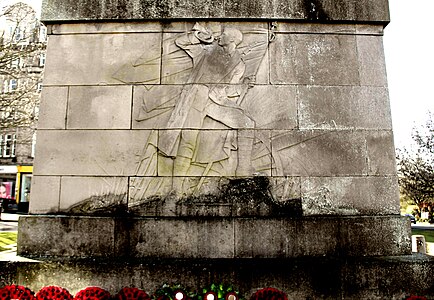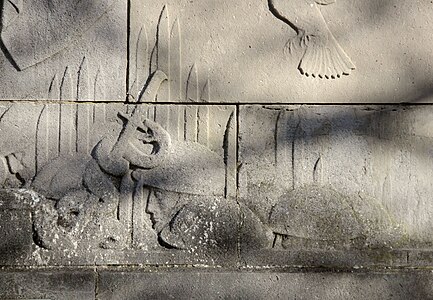
Harewood House is a country house in Harewood, West Yorkshire, England. Designed by architects John Carr and Robert Adam, it was built, between 1759 and 1771, for Edwin Lascelles, 1st Baron Harewood, a wealthy West Indian plantation and slave owner. The landscape was designed by Lancelot "Capability" Brown and spans 1,000 acres at Harewood.
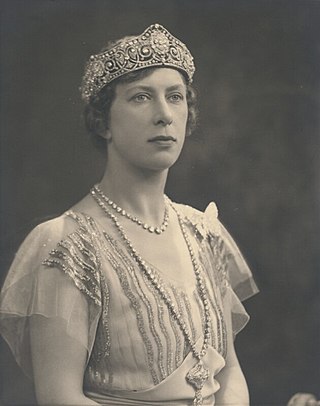
Mary, Princess Royal was a member of the British royal family. She was the only daughter of King George V and Queen Mary, the sister of kings Edward VIII and George VI, and aunt of Elizabeth II. In the First World War, she performed charity work in support of servicemen and their families. She married Henry Lascelles, Viscount Lascelles, in 1922. Mary was given the title of Princess Royal in 1932. During the Second World War, she was Controller Commandant of the Auxiliary Territorial Service. The Princess Royal and the Earl of Harewood had two sons, George Lascelles, 7th Earl of Harewood, and Gerald David Lascelles.

Harrogate is a spa town in the district and county of North Yorkshire, England. Historically in the West Riding of Yorkshire, the town is a tourist destination and its visitor attractions include its spa waters and RHS Harlow Carr gardens. 13 miles (21 km) away from the town centre is the Yorkshire Dales National Park and the Nidderdale AONB.
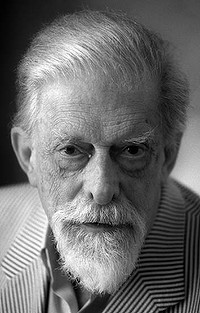
George Henry Hubert Lascelles, 7th Earl of Harewood, styled The Honourable George Lascelles before 1929 and Viscount Lascelles between 1929 and 1947, was a British classical music administrator and author, and a member of the extended British Royal Family, as a maternal grandson of King George V and Queen Mary, and thus a first-cousin of Queen Elizabeth II. He served as director of the Royal Opera House, chairman of the board of the English National Opera (ENO) (1986–1995); managing director of the ENO (1972–1985), managing director of the English National Opera North (1978–81), governor of the BBC (1985–1987), and president of the British Board of Film Classification (1985–1996).

Alwoodley is a suburb and civil parish of Leeds in West Yorkshire, England. It is 5 miles (8.0 km) north of central Leeds and is one of the most affluent areas of the county. Alwoodley lies in the LS17 postcode area which was reported to contain the most expensive housing area in Yorkshire and the Humber by The Times.
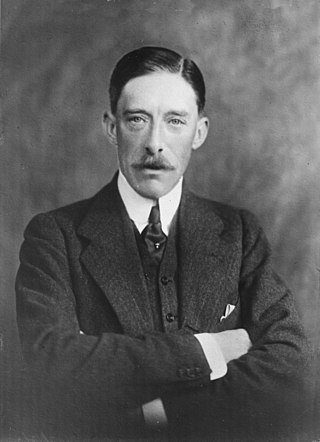
Henry George Charles Lascelles, 6th Earl of Harewood, known by the courtesy title of Viscount Lascelles until 1929, was a British soldier and peer. He was the husband of Mary, Princess Royal, and thus a son-in-law of King George V and Queen Mary and a brother-in-law to kings Edward VIII and George VI.

Goldsborough is a village and civil parish in North Yorkshire, England. It is situated near the River Nidd and one mile (1.6 km) east of Knaresborough. Goldsborough is recognised by the well-known stately home Goldsborough Hall and its other features including: Goldsborough Primary School, the Bay Horse Inn and the Goldsborough Cricket Grounds.

West Park United Reformed Church is located in the West Park area of Harrogate, England, and is a Grade II listed building. It was designed in Nonconformist Gothic style as West Park Congregational Church by Lockwood & Mawson and completed in 1862 for around £5,000. Along with Belvedere Mansion across the road, it was intended as part of the prestigious entrance to the Victoria Park development. For the Congregationalists it was meant to house an increasing congregation of visitors brought to the spa town by the recently-built railways. It became a United Reformed church in 1972.
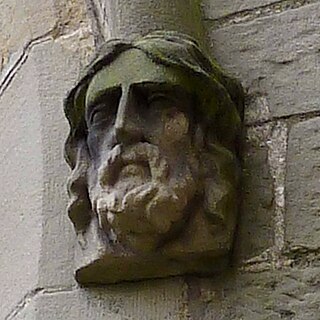
William Ingle was an architectural sculptor in Leeds, West Yorkshire, England. He specialised in delicately undercut bas relief and small stand-alone stone sculptures of natural and imaginary flora and fauna on churches and on civic, commercial and domestic buildings. He was apprenticed to his uncle Robert Mawer. After Mawer's death in 1854 he worked in partnership with his aunt Catherine Mawer and his cousin Charles Mawer in the company Mawer and Ingle. Notable works by Ingle exist on Leeds Town Hall, Endcliffe Hall, Sheffield and Moorlands House, Leeds. He sometimes exhibited gentle humour in his ecclesiastical work, such as faces peering through greenery, and mischievous humour on secular buildings, such as comic rabbits and frogs among foliage. He died of tuberculosis at age 41 years, having suffered the disease for two years.
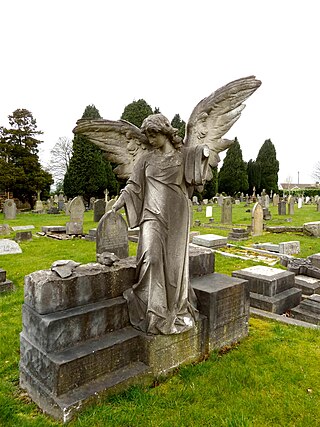
Harlow Hill Cemetery on Otley Road, Harrogate, North Yorkshire, England, is a local authority cemetery established on land donated by Henry Lascelles, 4th Earl of Harewood in 1869, and consecrated on 3 October 1871 by the Bishop of Ripon. It features the Gothic Revival Church of All Saints, designed by Isaac Thomas Shutt and Alfred Hill Thompson. It has individual memorials to casualties of World Wars I and II, and other graves include those of actor Michael Rennie and Catherine Gurney, an activist in the Temperance movement in the United Kingdom.

John Peele Clapham, from Leeds, West Riding of Yorkshire, was a justice of the peace for the West Riding of Yorkshire, and treasurer for the county courts of Yorkshire.

H. E. and A. Bown was an architectural practice in Harrogate, North Riding of Yorkshire, England, in the 19th and early 20th centuries. Its two partners were Henry Edwin Bown who started the business and died at the age of 36, and his brother Arthur Bown, who carried on the business until he retired in 1911.

The Jubilee Memorial, Harrogate, is a Grade II listed building. It is a Gothic Revival stone memorial in Harrogate, North Yorkshire, England, commemorating the 1887 golden jubilee of Queen Victoria. It was donated to Harrogate by its mayor, Richard Ellis, designed by architect Arthur Bown, and unveiled by the Marquis of Ripon.

Grove Road Cemetery, Harrogate, North Yorkshire, England, was formerly known as Harrogate Cemetery. It was established in 1864 after the spa town expanded and the graveyard at Christ Church became full. The cemetery once had a pair of chapels with spires, designed by Thomas Charles Sorby. Although they were admired by local residents who felt it enhanced the town view, they were demolished in 1958. However the lodge and gates, also designed by Sorby, remain.
John Smith was a Scottish banker and philanthropist. He was born in Aberdeen, Scotland, and spent most of his adult life running Beckett's Bank in Leeds, England. In retirement, he lived in Harrogate.

Frances Darlington was an English artist of the New Sculpture movement. In the early 20th century she created decorative panels, busts, garden statuary, medallions, group sculptures, and statuettes, in various materials including copper, bronze and painted plaster. She also designed a railway poster, featuring Ilkley.

Laura Sobey Veale, known as Dr Laura, was an English general practitioner, gynaecologist, and obstetrician. She was the first Yorkshire-born woman to become a doctor. She was refused entry to Leeds School of Medicine, even though the Leeds Mercury published letters of complaint about her treatment. With encouragement from Elizabeth Garrett Anderson and support from a local boys' school she was finally accepted at the London Royal Free Hospital School of Medicine for Women, and qualified with a Bachelor of Medicine (MB) degree at the age of 37.
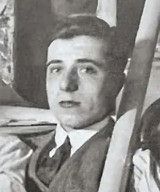
Ernest Prestwich was an English architect, working his own interpretation of Classical architecture, via the Style Moderne, Modernist and Brutalist styles. He specialised in war memorials and civic buildings, many of which are listed buildings. Some of his designs were independently-designed projects, and some were co-designs with colleagues. He was a partner with his father James Caldwell Prestwich and his brother Harold in Prestwich & Sons. and he also worked under his own name, and with Percy Thomas in various civic building design competitions.

Clifton House School was a private boys' preparatory school which flourished in Harrogate, North Riding of Yorkshire, England, between 1898 and 1968. It was founded in Clifton House in Queens Parade just as George Mearns Savery's Harrogate College for boys in Bilton was closing, thus acquiring the name of Clifton College, then Clifton House School. It kept that name until its last years when it became Clifton House Preparatory School. In 1909 the school established the first scout pack in Harrogate.

Harold Styan was an English gymnast and physical culturist in the music halls in his youth, a P.T. instructor and drill sergeant in the First World War, and a sports teacher and youth worker in Harrogate, Yorkshire, England, for the rest of his life.



